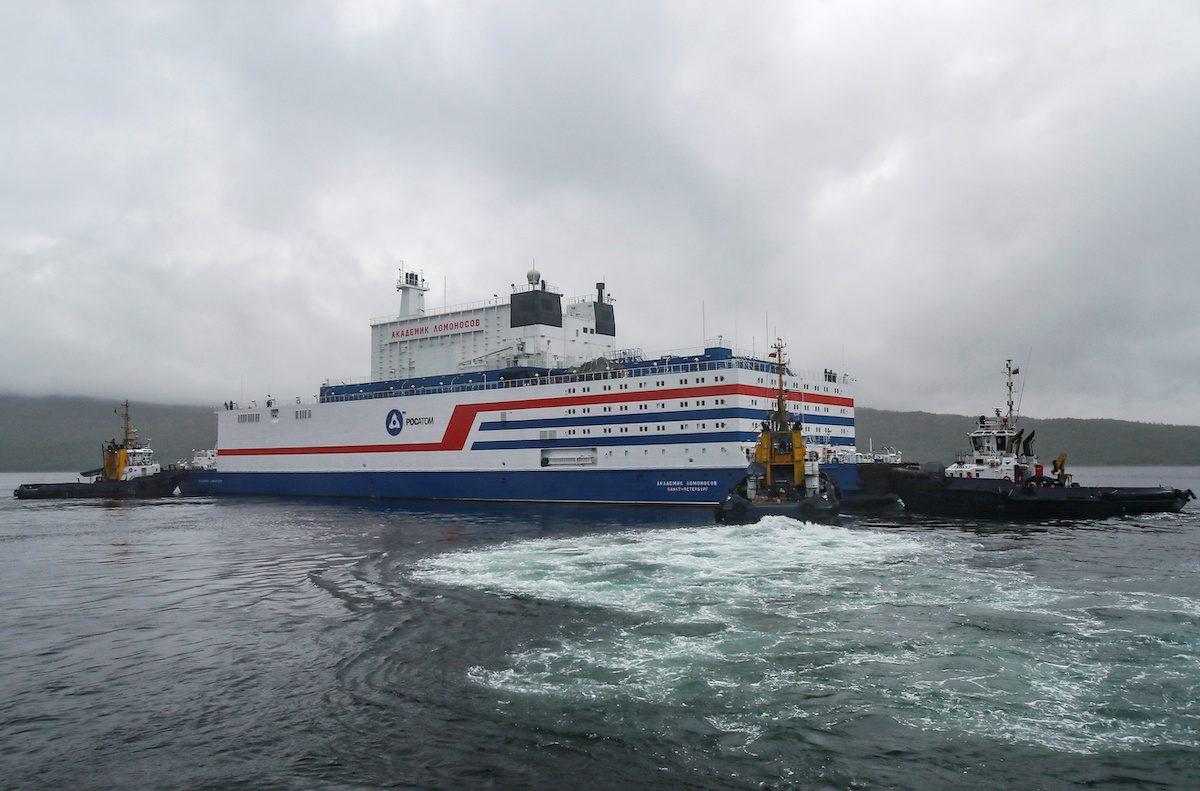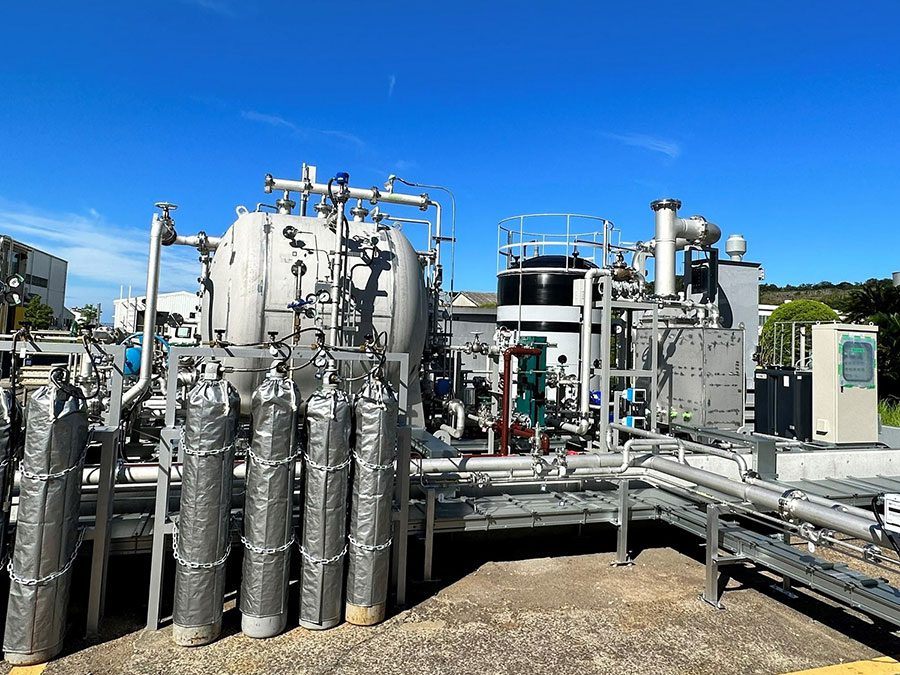Among the tiny number of small modular reactors in operation in the world right now are two on a ship floating off Russia’s far eastern coast. Russia is also still building commercial nuclear icebreakers.
By Will Wade (Bloomberg) The invasion of Ukraine has put the U.S. and Europe on a wartime mission to abandon Russian fossil fuels. This series looks at speeding up zero-carbon alternatives by lowering political and financial barriers.
Building big, conventional nuclear power plants is slow and expensive. That’s one reason the industry is staking its future on a new generation of smaller advanced reactors. Still in development, these offer the promise of carbon-free energy and could back up the ebbs and flows of renewable power in clean grids of the future.
As Russia’s war in Ukraine galvanizes Western countries to break their reliance on Russian energy exports, in part by accelerating green technologies that will replace fossil fuels, one solution could be boosting the deployment of nuclear energy. Advanced nuclear startup Oklo Inc. says it could build a new plant in about one year. It wouldn’t be big, but it could be ready quickly if the U.S. was willing to fast-track the regulatory process, said Oklo’s Chief Executive Officer Jacob DeWitte.
However, the type of fuel its reactor would run on is scarce—and mostly sourced from Russia right now. A domestic supply would take years to jump-start.
Also Read: Russia’s New Floating Nuclear Power Plant Sets Sail for the Arctic
Whereas conventional nuclear reactors have about 1 gigawatt (1,000 megawatts) of capacity, Silicon Valley-based Oklo has designed a 15-megawatt system that could provide clean power to about 10,000 homes. The first one would fit in a small warehouse and cost about $50 million. After that, additional systems could start rolling out of factories every three to six months, according to DeWitte, and could be assembled fast on-site, thanks to Oklo’s modular design.
“All this stuff, we could do it in months,” said DeWitte. “It takes time, but it’s not years.”
DeWitte says the design is ready to go, but he can’t proceed without a license from the Nuclear Regulatory Commission. Oklo submitted an application in 2020, which the agency kicked back in January, saying it was missing some key details. The company says its technology is different from conventional reactors and so was its application; it expects to submit a revised version by year’s end.
Related Book: Against the Tide: Rickover’s Leadership Principles and the Rise of the Nuclear Navy by Rear Adm. Dave Oliver USN
There have been lofty expectations of advanced nuclear for years but the nascent industry still has little tangible to show for them. On the current crisis footing, governments might throw more support behind the sector as a potential solution. If the U.S. government made it a national-security priority, much of the regulatory process could potentially be accelerated. There are already efforts on Capitol Hill to streamline the licensing process for small reactors.
Deploying more nuclear energy at home could eventually free up U.S. fuel supplies that could be routed elsewhere. And once the production process is in full swing, small modular reactors could be shipped in pieces and assembled overseas, easing other countries’ demand for coal or natural gas.
However, the NRC approval process is comprehensive and lengthy for a reason: the risk of a catastrophic accident. Even if companies say they’re ready to start construction, it may not be prudent to rush the process, said Chris Gadomski, head nuclear analyst for BloombergNEF, a clean energy research group. New reactors need to be vetted. And since none of them have ever been built before, bugs could emerge once they start moving from blueprints to factories.
Among the tiny number of small modular reactors in operation in the world right now are two on a ship floating off Russia’s far eastern coast.
Also read: Russian Firms to Build World’s Most Powerful Nuclear Icebreaker
“It’s a big thing, going from a PowerPoint reactor to being an actual reactor that’s in service,” Gadomski said. “When you license a nuclear reactor, if something goes wrong, everyone starts pointing fingers.”
Some small-reactor designs may be harder to accelerate. TerraPower LLC announced last year plans for a 345-megawatt plant in Wyoming that’s expected to go into service in 2028. The company, founded by billionaire Bill Gates, expects to submit its application for an NRC license late next year.
Even with full government support, construction will initially take four to five years, said Jeff Navin, TerraPower’s director of external affairs. Once production is going smoothly, subsequent plants would take about three years and cost about $1 billion each.
Part of the challenge is that most of these advanced reactors are using new technologies. Unlike the conventional nuclear plants in use today, TerraPower will use liquid sodium as a coolant instead of water. It will also include a molten-salt storage system to retain heat that will let the operators boost output when there’s strong demand for electricity. Oklo’s design uses liquid metal as a coolant.
“The first one always takes longer,” said Navin. “It will be about seven years from handshake to operation.”
Besides the engineering challenges of building something that’s never been built before, both companies, and some other advanced nuclear developers, expect to use a new type of fuel that’s currently in short supply. Fuel for conventional reactors is made with advanced centrifuges that enrich uranium to a concentration of about 4% to 5%. For HALEU—high assay low-enriched uranium—the same machines boost that to almost 20%. Most of the world’s supply of HALEU comes from Russia and there’s no commercial supplier in the U.S.
Watch: Amazing Time-Lapse Shows the World’s Biggest Nuclear Icebreakers
Centrus Energy Corp. is trying to fill that gap. The company already has NRC approval, as well as a demonstration line with 16 centrifuges that can make about 1 metric ton of HALEU a year. Chief Executive Officer Dan Poneman said he would need 42 months to install 120 centrifuges, enough to turn out 6 tons a year, and then six more months to add another 120 machines, for about $500 million to $1 billion.
The nuclear industry moves at a notoriously slow pace, in large part because of the critical safety concerns. However, the schedules outlined by companies pushing for the industry’s next-generation show that these advanced technologies may be ready in the near future.
“We can do this in a hurry when we put our minds to it,” said Poneman.

 Join The Club
Join The Club










